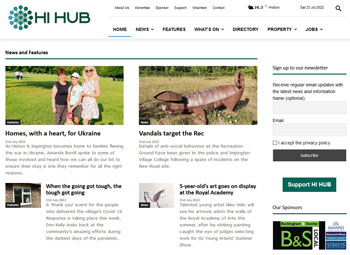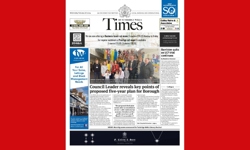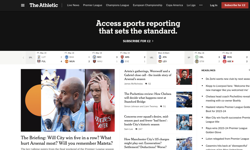
The rise of hyperlocals is one of the more interesting developments to be emerging from the challenges facing regional press. Their urban focus tends to mean that the stories most relevant to smaller towns and villages are covered intermittently or not at all. Yet in reality, even if located just a short distance from a major population centre, rural communities don’t tend to think of themselves as part of a bigger whole and each has its own unique and distinct identity. Small towns and many villages have infrastructure that includes schools, sports clubs, churches, parish councils, shops and other facilities that bind their communities together, creating a distinct identity and distinguishing them from their nearest cities and neighbouring villages.
The digital world has enabled these communities to reassert their identities and reject being classified as part of a much larger whole. This has been clearest of all through the growth of social media groups, offering more people micro-news and information to use in their daily lives. But social media have well documented drawbacks and there remains a gap for the publication of accurate and relevant local news and information in rural areas – a gap that hyperlocal publications can fill.
Birth
This gap is especially clear on the fringes of larger cities, and it was this that prompted the birth in early 2020 of the digital title HI HUB, serving the village of Histon & Impington. Just four miles north of central Cambridge, it is one of the larger communities in South Cambridgeshire, with around 9000 residents in 4000 households.

Before HI HUB, the village’s main communication channels comprised a popular Facebook group and a quarterly print publication produced by the parish council. This meant timely information about community events only reached Facebook users and accurate information about important local issues was difficult to distribute. Speculation and hearsay could gather pace, and the social media admins had their work cut out to keep the rumour mill in check and hostility at bay.
HI HUB was set up with the aim of plugging these gaps and providing a central, up-to-date source of news and information for the whole community.
Structure
Five executive board members supported by a paid part-time administrator are at the heart of the activity, running it as a not-for-profit enterprise through a Community Interest Company. In addition, a volunteer editorial team meets around three times a year, contributes occasional articles and prepares the property listings.
HI HUB’s start-up period was funded by a combination of parish and district council grants, community crowdfunding, advertising sales and sponsorship. It culminated with the launch of a WordPress website and a weekly email round-up that is auto-formatted from all content uploaded during the previous seven days, and pre-scheduled for sending once a week. News and feature stories are then shared on Facebook and Twitter.
It’s news that generates the most web traffic, with investigated stories and the activities of high street retailers and hospitality businesses proving especially popular. Council activity – or inactivity, crime reports, planning applications, traffic concerns and local campaigns and consultations all prompt good click-throughs from the email. Beyond this, What’s On listings, properties for sale / to let, job vacancies and features about community life and local people also attract good readership.
A directory of local traders and community organisations, clubs, societies and facilities provides a central reference point, with commercial organisations charged a modest fee for their directory listings and any advertising. Sponsors continue to contribute an additional income stream, and in total, we’ve generated enough to cover the ongoing costs.
Success
Since launch, around 1400 people have joined the email list to receive the weekly news bulletin, with an open rate of over 60%. Unique page views have climbed steadily to over 11,500 a month and feedback from the community has been universally positive. Editorial coverage has led to community events selling out, volunteers stepping forward for local clubs and societies, potentially damaging planning applications being seen off, and people finding jobs on their own doorsteps. Recent initiatives have included a popular ‘Shop Local’ campaign and a screen in the library window which streams the latest HI HUB content.
As for the business, we believe it is succeeding due to a series of related competitive advantages. The founding board has a combination of knowledge and skills that facilitated a very low-cost low-risk start-up. Two of the directors had previously set up and ran a specialist B2B digital publication, one as publisher and the other as editor, so were familiar with building online readership and the cost advantages of digital publishing over print. Another director is a WordPress developer, who was able to create the website, but also implement upgrades and introduce new functionality as required. The chair of the parish council and the admin for the village’s main Facebook group are the other board members, sharing their deep local knowledge of the market and connections to various community networks.
In the areas where our skills and knowledge are weaker, and / or we lack volunteers, we use our income to buy services. This includes employing a part-time administrator to handle email enquiries and requests, and to carry some of the admin load related to commercial activities. In-kind sponsors have helped keep costs down by providing accounting services and graphic design.
The volunteer / professional partnership is an important part of the business model. The volunteer input keeps costs low enough to ensure HI HUB can be free to readers (though donations are encouraged) and affordable to advertisers. The paid-for services provide the back-up for the volunteer team, which by definition works part-time, with everyone weaving their publishing activities around other commitments.
A close focus on a clearly defined market is also a key part of the mix. All content is selected purely on the basis of its relevance to the lives of people who see themselves as members of the Histon & Impington community, rather than ‘Cambridge’ or ‘South Cambridgeshire’.
Challenges
So far so good. But this tightly-defined definition of the market is also the source of the biggest challenges that lie ahead. Transforming our fledgling community enterprise into a long-term sustainable non-profit venture is the mountain still to be climbed.
Income generation is a problem that limits the extent to which we can buy in publishing services or employ staff. The potential for advertising revenues from local traders is constrained by the size of our target market, and HI HUB faces stiff competition from the local Facebook groups and word of mouth, both free of charge. Furthermore, although CICs can access funding from trusts and foundations, few grant-making bodies offer revenue funding opportunities for journalism and publishing.
Sales and marketing campaigns to build readership and attract advertisers and sponsors constantly fall off the table. Nearly all our time and efforts are needed to focus on the more pressing activities related to feeding and keeping updated a content-hungry website and publishing schedule.
What’s more, gathering news and information to sustain a tight focus on community issues is a time-consuming process that relies on having a finger on the pulse of local issues and opportunities. Some of these can be found by deep trawling through council minutes and scanning district and region-wide sources to find stories that are relevant to our village. Others lie below the radar and emerge through informal community networks, personal contacts and local gossip, including social media. Keeping on top of this is a big ask of volunteers.
Perhaps the most significant challenge of all though is that volunteers need relevant skills – and often local knowledge – as well as enthusiasm. This means either finding the few people in our community with the relevant expertise who are willing and able to give their time freely, or finding suitable training for those who want to learn. The crunch point will come when founding directors need or want to reduce their commitment. HI HUB currently relies on the combined skills and efforts of these ‘expert’ volunteers, which will be difficult to replace.
The way ahead
Our membership of the Independent Community News Network (ICNN) has been hugely valuable, not least in showing us that we are not alone and hyperlocals across the UK are tackling similar challenges.
Some have made significant progress. Their business models suggest that building economies of scale without losing community identity is key to sustainable growth. For example, Social Spider publishes five print titles serving different areas of North and East London, while Social Streets, a ‘digital first’ publisher, serves various communities in East London. What they have in common is their social ethos, non-profit status and, above all, their treatment of different readers as belonging to separate communities, rather than as parts of a larger whole.
Although these examples are city-based, it’s a model that could play to the strengths of rural areas like South Cambridgeshire, and HI HUB is now reaching out to other communities in the district to see whether a collaborative approach could create a more attractive market for advertisers and opportunities for sharing costs. It’s early days, but an opportunity for several small communities to share more paid-for support, especially in business development, editorial and web services, could potentially lead to the stable long-term business model we are searching for.
This article was first published in InPublishing magazine. If you would like to be added to the free mailing list to receive the magazine, please register here.










